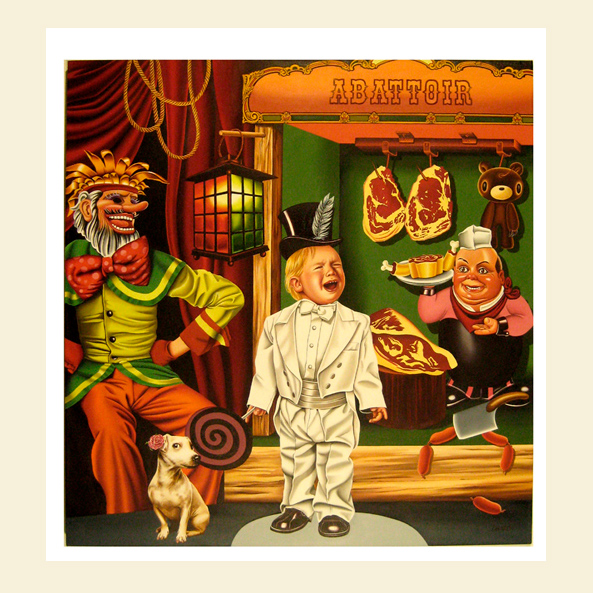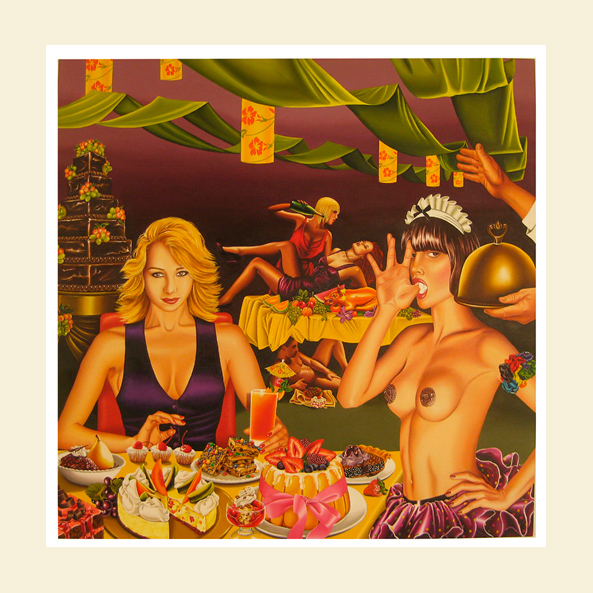SEVEN DEADLY SINS — SERIES
The line dividing good and evil cuts through the heart of every human being. And who is willing to destroy a piece of his own heart?– Aleksandr Solzhenitsyn

SCHOOL FOR ANGELS
52″ x 48″ – 2012
LUST
(Hell Mouth Wagon III)
oil on canvas
“School For Angels”
Hell Mouth Wagon III houses “Lust”. The most beautiful fallen angel of all coaches two young acolytes. He is seated on a bench—using the imagery of the Sutton Benger Green Man. Surrounded by hawthorn leaves, the green man’s face has an almost melancholic sinister expression of acceptance—a reminder of man’s fragile existence.

WINNER TAKES ALL
52″ x 48″ – 2012
GREED
(Hell Mouth Wagon II)
oil on canvas
“Winner Takes All”
Greed resides in Hell Mouth Wagon II. Greed has become synonymous with Wall Street, so it seemed appropriate to feature a successful young derivatives trader basking in his good fortune. The world is his . . . for a while. Included is Arturo DiModica’s iconic Wall Street bull; A cornucopia (derived from the horn of the goat Amalthaea, it filled itself with whatever its owner requested); and that most cheerful of all givers, Santa Claus.
The artist, yours truly, wearing a LIARS MASK and harlequin outfit, sounds a cautionary note: An appropriate role for an artist, that of trickster.

THE SKELETON AT THE FEAST
52″ x 48″ – 2011
[MIXED SINS]
(Hell Mouth Wagon I)
oil on canvas
“The Skeleton at the Feast”
Takes place in Hell Mouth Wagon I. It depicts mixed sins from both categories: commission and omission. There is but one certainty in life—that we will all die. The skeletons proclaim “Memento Mori”.

ABATTOIR
48″ x 46″ – 2011
WRATH
oil on canvas
Sweeney Todd (who worshipped a dark and vengeful god) made me create “Abattoir”. That drama is the first thing that pops into my mind when I hear the word “vengeance”. So here’s a vulnerable child encountering wrath in a little theatre of horrors.

SUGAR AND SPICE
36″ x 48″ – 2011
ENVY
oil on canvas
“Sugar and Spice” is fueled by sibling and/or teen age rivalry between young girls. As I remember, jealousy was rife during those years. Teen age angst aside, jealousy persists throughout our lives, affecting both sexes and all age groups. Jealousy frequently results in ruined or lost lives, as Othello’s flaw clearly demonstrates.

INSATIABLE
48″ x 48″ – 2010
GLUTTONY
oil on canvas
“Insatiable” takes a somewhat celebratory view of gluttony. These sins do overlap so there is some lust and greed at this party for good measure. Bon appétit!

BURNERS
48″ x 50″ – 2010
oil on canvas
“Burners” is inspired by the Burning Man festival, an event set in the Nevada desert. Lust decrees that clothing is optional, drugs are plentiful, and anything goes.
In this uncertain age when the difference between right and wrong is no longer clear, what significance does the concept of the Seven Deadly Sins have?
The old mechanism of guilt has disappeared, or lost ground when it remains at all, since Western religion, at least, no longer seeks to frighten sinners. In terms of today’s morality, Faust simply lacks the psychological software to comprehend the wrong he commits until it is too late.
I regard the seven root sins (Gluttony, Vanity, Greed, Lust, Sloth, Wrath, Envy) as components of the human psyche; as character traits that might very well have been beneficial to the survival and success of our species. When those same tendencies are unconstrained and excessive, the results are negative, or simply put: “sinful”.
It’s been said, for instance, that from the first day of its existence forward to now, sheer greed was the driving spirit of civilization: Wealth and again wealth, and once more wealth.
GREED, (like the other six “sins”), is a constant. If we are going to indict a long line of greedy, avaricious plutocrats for the ills of society, whether financial crises or the death of the American dream, we also have to credit them with all the intervening periods of prosperity, for patronage of the arts, for the building of libraries, etc.
These are topics worthy of our attention and for this artist; the Seven Deadly Sins still fire the imagination.
Three of the paintings [“The Skeleton at the Feast”, “Winner Takes All”, and “School For Angels”] take place in Hell Mouth Wagons. These were 16th century pageant wagons that headed the procession of stages for Passion Plays. Similar to our modern-day floats, they would not be out of place in a Mardi Gras parade.
©2024 by IVESTER creative